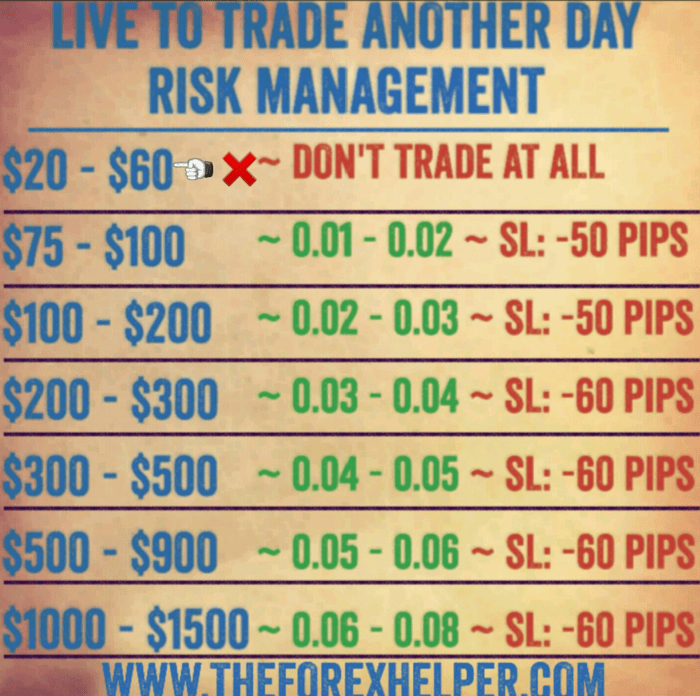Forex risk management is a crucial aspect of currency trading, enabling traders to navigate market volatility and protect their capital. By understanding the types of risks involved, implementing effective risk management strategies, and leveraging technology and psychological insights, traders can mitigate risk and enhance their trading outcomes.
This comprehensive guide delves into the dynamics of the forex market, explores the different types of forex risk, and provides practical risk management techniques. It also examines the role of risk assessment and analysis, discusses the benefits of risk mitigation tools, and explores the psychological factors that can impact trading decisions.
Forex Market Dynamics

The forex market is the largest and most liquid financial market in the world, with a daily trading volume exceeding $5 trillion. It involves the exchange of currencies between participants from different countries, facilitating global trade and investment.
Key participants in the forex market include central banks, commercial banks, investment banks, hedge funds, and retail traders. The value of currencies is determined by supply and demand, influenced by various factors such as economic growth, interest rates, inflation, political stability, and global events.
Major currency pairs, such as EUR/USD, USD/JPY, and GBP/USD, account for a significant portion of forex trading. These pairs exhibit distinct trading patterns based on economic conditions, market sentiment, and technical analysis.
Types of Forex Risk

Forex trading involves various types of risks that traders must be aware of and manage effectively.
- Market Risk: Fluctuations in currency prices due to economic, political, or geopolitical events can lead to losses for traders.
- Liquidity Risk: The inability to quickly and efficiently buy or sell a currency pair at a desired price, potentially resulting in slippage or missed opportunities.
- Credit Risk: The risk that a counterparty in a forex transaction fails to fulfill its obligations, leading to financial losses for the other party.
Historical events, such as the 2008 financial crisis or the Swiss franc peg removal in 2015, have demonstrated the significant impact of these risks on forex markets.
Forex risk management is crucial to protect your capital and ensure profitability in the long run. Before venturing into the markets, it’s essential to open a forex account with a reputable broker. This provides you with access to the necessary trading tools and resources.
Once your account is set up, you can develop a comprehensive risk management strategy that aligns with your trading style and risk tolerance.
Risk Management Strategies
Effective forex risk management involves implementing strategies to mitigate potential losses and protect capital.
- Stop-Loss Orders: Automatic orders that trigger the sale or purchase of a currency pair at a predefined price, limiting potential losses.
- Hedging: Using financial instruments, such as options or futures, to offset the risk of price movements in a particular currency.
- Diversification: Trading multiple currency pairs or asset classes to reduce the overall risk exposure to any single market.
These strategies can be customized to suit individual risk tolerance and trading styles, enhancing the likelihood of successful forex trading.
Risk Assessment and Analysis
Risk assessment and analysis are crucial for informed decision-making in forex trading.
Common methods include:
- Historical Analysis: Examining historical price data to identify patterns and potential risks.
- Technical Analysis: Using technical indicators and chart patterns to forecast price movements and assess risk.
- Fundamental Analysis: Analyzing economic, political, and geopolitical factors that influence currency values.
Interpreting and utilizing risk analysis results enables traders to make informed decisions, adjust trading strategies, and manage risk exposure proactively.
Risk Mitigation Tools
Technology and tools play a vital role in mitigating forex risk.
Forex risk management is essential for any trader looking to navigate the unpredictable currency markets. Forex trend trading , which involves identifying and trading in the direction of prevailing market trends, can help traders mitigate risk by providing a framework for making informed trading decisions.
However, even with trend trading, risk management strategies remain crucial to ensure the preservation of capital and the long-term profitability of trading endeavors.
Risk management platforms and software offer features such as:
- Real-Time Risk Monitoring: Continuous tracking of market conditions and risk exposure.
- Automated Risk Alerts: Notifications when risk parameters are exceeded.
- Scenario Analysis: Simulating different market scenarios to assess potential risks and develop mitigation strategies.
These tools enhance trading decisions, reduce risk exposure, and improve overall risk management practices.
Behavioral and Psychological Factors
Behavioral and psychological factors can significantly impact forex trading risk.
Common biases and emotions include:
- Overconfidence: Exaggerated belief in one’s trading abilities, leading to excessive risk-taking.
- Fear of Missing Out (FOMO): Emotional response to market movements, driving traders to make impulsive decisions.
- Confirmation Bias: Seeking information that confirms existing beliefs, ignoring contradictory evidence.
Strategies for managing these factors include self-awareness, risk tolerance assessment, and developing a disciplined trading plan.
Wrap-Up
By embracing a proactive approach to forex risk management, traders can gain a competitive edge in the fast-paced and ever-changing world of currency trading.
This guide provides a roadmap for developing a robust risk management framework, empowering traders to make informed decisions, minimize losses, and maximize their trading potential.
Question & Answer Hub: Forex Risk Management
What is the most common type of forex risk?
Market risk, which arises from fluctuations in currency exchange rates.
How can I mitigate credit risk in forex trading?
By trading with reputable brokers and avoiding overleveraging.
What is the role of stop-loss orders in risk management?
To automatically close positions when they reach a predetermined loss level.




